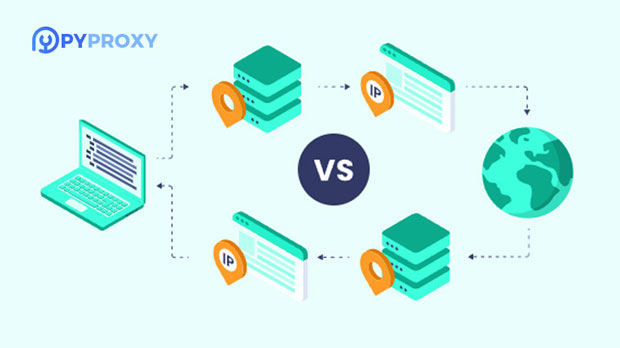In recent years, the rapid growth of online business operations, cybersecurity concerns, and data-driven strategies have driven enterprises to seek more robust and efficient methods of managing and securing their digital infrastructure. A key component in this landscape is the increasing demand for enterprise-level proxy detection. As cybercriminals employ proxies to hide their identities, businesses are left vulnerable to fraud, data scraping, and other malicious activities. To address these challenges, tools like PYPROXY Proxy Checker have emerged as crucial solutions, becoming a focal point in the industry. This article delves deeper into the reasons behind the rising demand for proxy detection and the importance of solutions like PyProxy in ensuring secure digital environments. Understanding Proxy Detection and Its Significance in Today's Digital LandscapeProxies are intermediary servers that allow users to mask their real IP addresses, providing anonymity and hiding their geographic locations. While proxies can be used for legitimate purposes such as privacy protection or bypassing geographic restrictions, they are also employed by cybercriminals for malicious activities. From preventing unauthorized access to scraping sensitive information, proxies are often used to shield fraudulent activities from detection. As enterprises rely heavily on data and online platforms, the need for effective proxy detection has become more urgent. Without proper proxy management and detection, businesses face increased risks of fraud, account takeovers, and sensitive data leaks. Consequently, businesses are turning to specialized tools like PyProxy Proxy Checker, which provides an efficient and scalable solution for identifying and mitigating proxy-related threats.The Growing Demand for Enterprise-Level Proxy DetectionSeveral factors contribute to the escalating need for enterprise-level proxy detection tools. Among the most significant reasons are the rise in cybercrime, the increasing use of automated bots for data scraping, and the growing importance of data privacy regulations.1. Rise of Cybercrime: Cybercriminals constantly evolve their tactics, often using proxies to mask their activities and evade detection. Proxies are used for a range of malicious activities, from launching DDoS (Distributed Denial of Service) attacks to orchestrating fraudulent transactions. Enterprises, especially in e-commerce, finance, and social media, are particularly vulnerable to such threats. As businesses collect more data and expand their online presence, protecting their platforms from proxy-based attacks has become a high priority.2. Data Scraping: Another significant challenge driving the demand for proxy detection is data scraping. Malicious bots often use proxies to gather data from websites without authorization, leading to significant business losses. Whether it’s scraping product pricing, market research data, or intellectual property, businesses need to implement effective proxy detection systems to safeguard their digital assets. 3. Regulatory Requirements and Data Privacy: With data privacy regulations such as GDPR becoming more stringent, businesses must ensure they maintain a secure digital environment for their users. Proxies are commonly used to bypass geographical restrictions, which may result in non-compliance with privacy laws. Enterprises must adopt comprehensive proxy detection tools to ensure that their digital infrastructure remains compliant and secure.How PyProxy Proxy Checker Addresses These ChallengesPyProxy Proxy Checker has emerged as one of the most trusted solutions for enterprise-level proxy detection. Designed for scalability and efficiency, it provides businesses with an easy way to identify and mitigate the risks associated with proxy usage. Here's how PyProxy stands out:1. Advanced Proxy Detection Algorithms: PyProxy Proxy Checker uses advanced algorithms that can accurately detect proxy usage in real-time. By analyzing traffic patterns, IP addresses, and other characteristics, the tool identifies suspicious activity and helps businesses pinpoint potential threats.2. Scalability for Enterprises: Unlike basic proxy detection tools, PyProxy is built to handle high traffic volumes, making it ideal for large enterprises. Whether it's for monitoring web traffic, securing e-commerce platforms, or preventing fraud, PyProxy can scale to meet the growing demands of businesses across various industries.3. Integration with Existing Systems: One of the key advantages of PyProxy is its ability to seamlessly integrate with existing enterprise systems, such as firewalls, intrusion detection systems, and customer relationship management (CRM) platforms. This ensures that businesses can add an extra layer of security without disrupting their existing infrastructure.4. Real-Time Reporting and Alerts: PyProxy provides real-time reporting and alerts, allowing businesses to act swiftly when proxy-related threats are detected. This proactive approach ensures that companies are always a step ahead of cybercriminals, minimizing the risk of data breaches or fraud.5. Comprehensive Proxy Database: PyProxy maintains an extensive database of known proxy ips and their associated behaviors, ensuring that businesses can detect both residential and data center proxies. This feature enhances the tool’s accuracy and effectiveness, making it a valuable asset for enterprises concerned with identifying sophisticated proxy threats.Benefits of Implementing PyProxy Proxy Checker for BusinessesThe benefits of implementing PyProxy Proxy Checker in an enterprise’s security infrastructure are substantial. Below are some of the key advantages businesses can experience:1. Enhanced Security: By accurately detecting and blocking proxy usage, PyProxy helps prevent fraud, account takeovers, and unauthorized access to sensitive data. This is especially important for industries like e-commerce and finance, where the protection of user data is paramount.2. Improved Customer Trust: With cybersecurity becoming a growing concern for consumers, businesses that invest in robust proxy detection systems can build trust with their customers. Proactive security measures show that a company values customer privacy and is committed to safeguarding their data.3. Compliance with Regulations: By ensuring that no unauthorized proxies bypass geographical restrictions or access sensitive data, PyProxy helps businesses remain compliant with data privacy regulations. This is particularly crucial for enterprises operating in regions with strict data protection laws, such as the European Union.4. Reduced Risk of Financial Losses: Proxy-based attacks, including fraudulent transactions and data scraping, can result in significant financial losses for businesses. PyProxy minimizes these risks by providing real-time threat detection, helping enterprises protect their bottom line.5. Cost-Efficient Solution: While building custom security solutions can be expensive, PyProxy offers a cost-effective alternative. It provides comprehensive proxy detection capabilities without the need for extensive in-house development, making it an attractive choice for businesses of all sizes.The Future of Proxy Detection and the Role of PyProxyAs the digital landscape continues to evolve, the need for effective proxy detection tools will only grow. With advancements in artificial intelligence and machine learning, future versions of PyProxy may incorporate even more sophisticated methods of identifying proxy usage, further enhancing security capabilities.Moreover, as businesses continue to embrace digital transformation, the demand for scalable, real-time security solutions will only increase. PyProxy, with its powerful features and enterprise-grade capabilities, is well-positioned to remain a leader in the proxy detection space.In conclusion, as proxy-based threats become more complex and prevalent, tools like PyProxy Proxy Checker will play a vital role in helping businesses maintain secure and compliant digital environments. By leveraging such tools, enterprises can protect themselves from a wide range of cyber threats, safeguard sensitive data, and build a more secure online presence.
Nov 06, 2025



































































